So
Government has finally revealed the real reason for building
the new Government Office at Tamar and destroying part of
our shoreline - to take an extremely useful and valuable
building on Government Hill away from the Community and
give it to a developer to destroy, and also destroy "Government
Hill" itself by hollowing it out.
The
community needs this building. Save our Shorelines reminds
the Government that the land is zoned "COMMUNITY"
and it is NOT FOR SALE.
For
more on the history of "Government Hill" ... view
the Powerpoint presentation click
here
Tamar
...
Green Light to sell Government Hill to developers.
| Will
this be the new face of Central?
South
China Moning Post - CHLOE
LAI - Saturday,
May 20, 2006
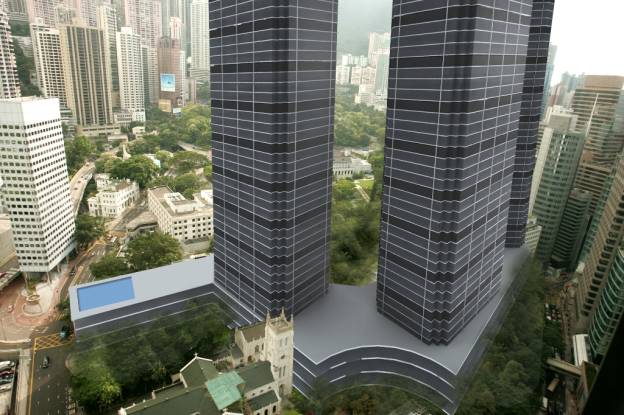
(Click
image to zoom)
"...
Officials suggested last summer that selling [Government
hill] would cover Tamar's development cost."
"Government
Hill is certain to be on the auction block if moving
CGO to Tamar is approved"
John Bowden, Chairman SOS.
|
Sign
the petition to
stop them
in co-operation with
Clear The Air
... click
here
|
|
|

The
CENTRAL HARBOUR FRONT, GOVERNMENT HILL and TAMAR
QUESTIONS
RELATING TO RELOCATION OF
ADMINISTRATION OFFICE
TO TAMAR SITE
What
happens if the offices move
and what happens to the CGO site afterwards
To
the director of Administraion, Friday May 19th 2006
click
here for .pdf file |
Activists
warn of the impact if prime government site is exploited
to the full
Three 70-storey towers providing 5.4 million sq ft of office
space could be built on a podium at the site of the Central
Government Offices if the land goes into private hands and
is developed to its full potential, harbour activists warn.
John
Bowden, chairman of Save Our Shorelines, said the city would
either have a three-tower development on Lower Albert Road
that would be taller than The Peak, or four 50-storey towers
which would create a wall effect, altering air flow and
blocking the views of Mid-Levels residents.
He
described the group's estimate as conservative, since developers
could easily boost density by increasing the plot ratio.
"The
[Central Government Offices] site is currently covered to
less than 10 per cent of its potential," Mr Bowden
said, adding that the site had no height restriction, while
ridge-line protection was non-binding. Ridge-line protection
refers to the recommendation that views to the ridges and
peaks be partly building-free.
Officials
have so far refused to discuss the future of the site if
the government moves its headquarters to Tamar. However,
officials suggested last summer that selling the site would
cover Tamar's development cost.
The
harbour group believed a podium would likely be built in
any office tower development because it would create retail
rental space.
According
to a government-commissioned report on the development potential
of the offices' West Wing, released two months ago, there
was retail potential if the site was used for commercial
purposes.
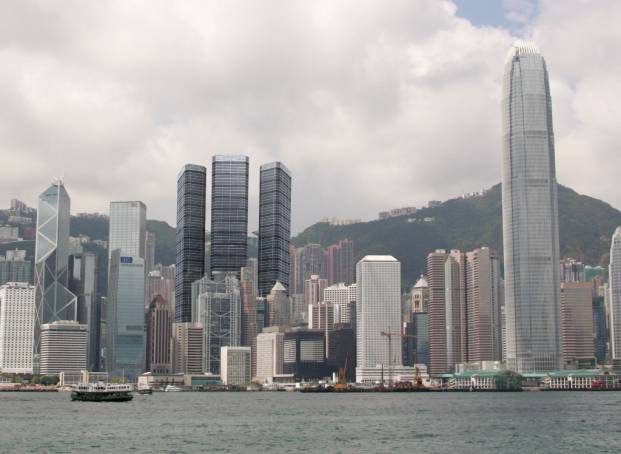 The
report also said it was possible for developers to increase
the site's density and plot ratio.
The
report also said it was possible for developers to increase
the site's density and plot ratio.
"It
is traditional for developers to seek to maximise the gross
floor area and the plot ratio through the dedication of
ground floor areas to public use and as a result, secure
an increase in the gross floor area equivalent to five times
the amount dedicated," the report said.
"We
would anticipate that much of the podium deck at the Lower
Albert Road level will be dedicated to public use, and indeed,
on the basis of some very preliminary calculations, it may
be possible to achieve an increase in the plot ratio/gross
floor area to the maximum permitted, namely 18:1."
Mr
Bowden said that relocating the government headquarters
to Tamar "holds the potential for further damage to
the environment if the land is sold for commercial redevelopment".
He
also warned of increased traffic congestion and an impact
on air quality if the site was built to the maximum potential.
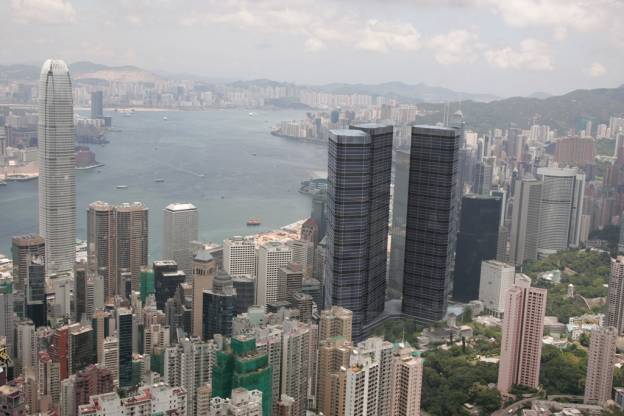 According
to a ten-year old Government study, the existing CGO buildings
are grossly under-utilized, and it is now clear that following
the relocation of government premises to the Tamar site
they could be developed in future into three seventy-storey
towers that would impact the Central skyline blocking the
Peak forever. This is illustrated in a report issued on
19th May by the community group Save Our Shorelines, which
questions the government’s separation of Tamar Development
plans from redevelopment plans at the Central Government
Office mid-level sites when the various bureaus move.
According
to a ten-year old Government study, the existing CGO buildings
are grossly under-utilized, and it is now clear that following
the relocation of government premises to the Tamar site
they could be developed in future into three seventy-storey
towers that would impact the Central skyline blocking the
Peak forever. This is illustrated in a report issued on
19th May by the community group Save Our Shorelines, which
questions the government’s separation of Tamar Development
plans from redevelopment plans at the Central Government
Office mid-level sites when the various bureaus move.
SOS
Chair John Bowden says: “Assuming standard commercial
development plot ratios in Hong Kong, the site would be
of enormous financial value. However, if the site is fully
developed there will be huge environmental impacts. If height
restrictions are imposed then the values drop, and the landsale
will not bring the community any real benefit at all. It’s
a lose-lose situation”. The group suggests that the
existing CGO and Murray Road offices should be retained
and retrofitted at far less cost - and with less waste -
than the proposed new 30 and 40-storey offices at Tamar.
All the required facilities could be accommodated there
and additional space could be provided for Legco offices
by redeveloping the Murray Road Car Park, site of the current
ICAC offices.
Santa
Raymond – office specialist and author of the book
‘Tomorrow’s Office’, an in-depth study
of the commercial workplace, commenting on the administrations’
reluctance to retain and improve the existing Central Government
Offices says: “With wireless networking, and comprehensive
workplace planning, the existing space can certainly be
retrofitted to the highest standards to meet current and
future needs. Disruption can be minimised by careful phasing,
and huge cost savings are possible. This is what responsible
governments and corporations are doing all over the world”.
The
SOS report also refers to community concerns that the strong
feng shui associated with the current CGO site would not
be replicated at Tamar and might lead to fears that benefits
currently enjoyed at the CGO sites would be lost to the
Government in the future.
SOS
supports proposals recently presented to the Legco Subcommittee
on Planning and Works that show the Tamar site developed
as low level, small plot sizes reminiscent of Shanghais’
Xin Tian Di. Bowden added “ we believe that the right
solution is for Government to remain in its existing historic
centre, to re-fit at lower cost and add space there to improve
the way they work and to retain the shoreline sites for
low level commercial development that will have a long term
value for the community”.
Representatives
from SOS met on Friday with the Director of Administration
to present the report and to ask why the CGO retention and
improvement option had been dismnissed without a comprehensive
study of the financial benefits being completed.
...
SOS says "save
Tamar and Government Hill - use the Murray Road Carpark
site for more space"
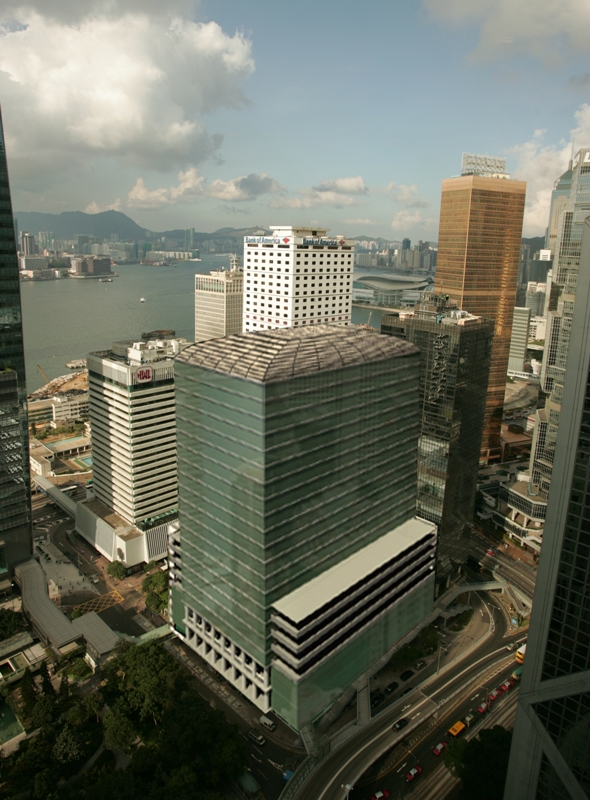
SOS
Submission to the Town Planning Board - updated Jul 2005
We
do not need a Bypass -
but if we can't stop the Govenrment from building one, then
put it under the water!
SOS
has made a submission to the Town Planning Board that shows
that the proposed Central Wanchai Bypass can be put under
water - we can remove almost all the reclamation. Two consulting
reports by Hyder and Maunsell showed that this was feasible
from the very beginning and there was at least one original
tender that showed the bypass built mostly underwater. So
what happened? Why did the Government start the reclaimation
and why won't they stop?
Here
are two views of the harbour. One is the way it should be,
the other is the proposal for Wanchai.

|

|
| View from Convention Centre Today -
under water "Bypass" can be built.
(click to zoom) |
Proposed surface road nicknamed
P2 on top of the underground "Bypass" (click
to zoom) |
Why
did they choose the more expensive option?
Comparison
of costs Reclamation
vs. Underwater "Bypass"
Costs from the
'Item for the Public Works subcommittee of the Finance Committee'
Central reclamation
phase III - engineering works
http://www.legco.gov.hk/yr01-02/english/fc/pwsc/papers/p02-41e.pdf
In millions of HK$ - Elements of CR III
| |
Reclamation Plan |
Underwater Plan |
Elements of Central Reclamation
III engineering works |
| a |
456 |
91 |
Reclamation |
| b |
444 |
444 |
Seawalls |
| c |
115 |
0 |
Road works |
| d |
149 |
149 |
Depressed road and underpass |
| e |
32 |
32 |
Public transport interchanges |
| f |
90 |
90 |
Footbridge and covered walkway |
| g |
43 |
0 |
Sewerage and drainage works
in reclamation |
| h |
254 |
254 |
Box culverts |
| i |
32 |
32 |
hinterland drainage improvements |
| j |
39 |
39 |
PLA berth |
| k |
442 |
442 |
Ferry piers and public piers |
| l |
44 |
0 |
Waterfront pumping stations
for future developments |
| m |
271 |
0 |
Reprovisioning of Gevernment
cooling water pumping systems |
| n |
348 |
0 |
Reprovisioning of private cooling
water pumping systems |
| o |
116 |
116 |
Relocation of Govt. helipad and PCWA |
| p |
56 |
56 |
Landscaping |
| q |
15 |
15 |
EM&A programme |
| r |
325 |
325 |
Consultant fees |
| s |
20 |
20 |
NCSC staff |
| t |
329 |
329 |
Contingencies |
| u |
-59 |
-59 |
Price Adjustments |
| |
3,562 |
2,376 |
TOTALS |
| |
|
|
|
| |
|
|
HK$ 1,186 Billion Savings |
Saturday,
November 1, 2003
South
China Morning Post
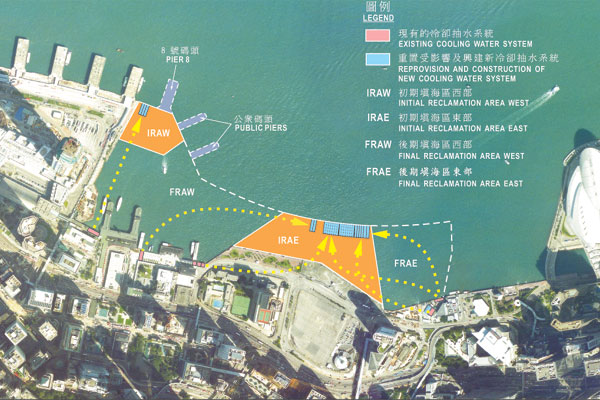 Harbour
tender 'breaches WTO rules'
Harbour
tender 'breaches WTO rules'
Contract process
for Central project was unfair and should be started again,
says review panel
CHEUNG CHI-FAI and STELLA LEE
The controversial Central reclamation project has been thrown
into further jeopardy after the government was found to
have breached World Trade Organisation tendering rules in
awarding the contract.
In a ruling handed down on Thursday, a review panel said
the government was not being fair in changing the tendering
conditions of the third phase of the reclamation after the
tender was closed.
The result of changing the conditions was that the contractor
which submitted the lowest bid, China Harbour Engineering
Company, failed to be awarded the contract, which went to
a joint venture between Leighton Contractors, China State
Construction Engineering (Hong Kong) and Dutch marine works
firm Van Oord ACZ, whose bid was worth $3.8 billion.
While
the ruling of the Review Body on Bid Challenges is not legally
binding, it has recommended the project be retendered. The
ruling has added a new twist to the controversy surrounding
the project, which has been mothballed pending the outcome
of a legal challenge by the Society for the Protection of
the Harbour that the Central-Wan Chai reclamations breach
the Protection of the Harbour Ordinance. The bone of contention
involved the cost of works related to the Central-Wan Chai
bypass. The government originally required the cost of building
the bypass to take up at least 33.7 per cent of the total
cost of the phase three reclamation.
When
the tender was closed on November 8, 2002, four contractors
- Leighton, China Harbour, Penta-Ocean-Paul Y-BSGL Joint
Venture and Gammon Skanska - put in their bids, but only
China Harbour complied with the condition. But after learning
that the reclamation might be jeopardised by a legal challenge
from environmentalists, the Territory Development
Department (TDD) proposed to the Central Tendering Board
in January this year that the bypass cost be excluded from
the evaluation.
The
board took the advice. As a result, Leighton, whose tender
scored highest in the assessment exercise after the tendering
conditions were changed, was awarded the contract on February
6. On February 8, China Harbour requested a meeting with
the TDD, hoping to raise an objection. The TDD did not reply
and issued a letter of acceptance to Leighton on February
10.
China
Harbour then challenged the tendering decision, saying it
had not been told about the changes of the tendering conditions
before the close of tender.
A
three-member panel, chaired by Neil Kaplan, QC, was set
up in April to consider the complaint.
The
panel said while it did not dispute that the government
must reserve the right to accept a non-compliant tender
in some circumstances, the administration "did not
act fairly or transparently".
"[China
Harbour] complied with the condition. They were the lowest
tenderer. Then without the [government] going back to them,
the rug is pulled from under their feet," the panel
said. It concluded there was "too much haste"
in the tendering process and the government had violated
the WTO's Government Procurement Agreement, which aims to
maintain a fair, and transparent procurement process.
While
the government's decision to change its tendering condition
had effectively turned China Harbour's bid from the lowest
to the highest, the tenderer was never made aware of it.
"The
panel considers it unrealistic to recommend that the contract
be given to China Harbour in place of Leighton, even though
that is the inevitable conclusion of the panel's finding,"
it said.
"The
panel considers that a fairer way of proceeding would be
to ask both China Harbour and Leighton, to retender in the
light of the position as it is now."
However,
the panel conceded that the ruling was not legally binding
and the government had to make its own decision on what
course of action it had to take.
The
government said last night it was still studying the ruling.
China Harbour also said it was seeking professional advice.
A
Leighton spokesman said the government had not discussed
the option of retendering so far, but the company would
be disappointed if such a decision were made.
Engineering
sector legislator Raymond Ho Chung-tai said the government
has a dilemma as it would face huge claims whether it decided
to retender or not.


